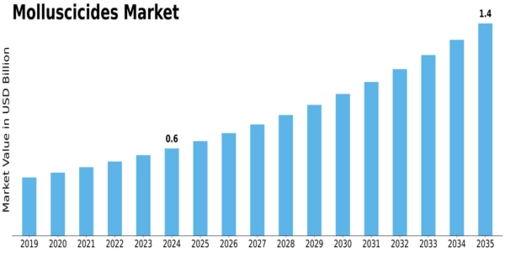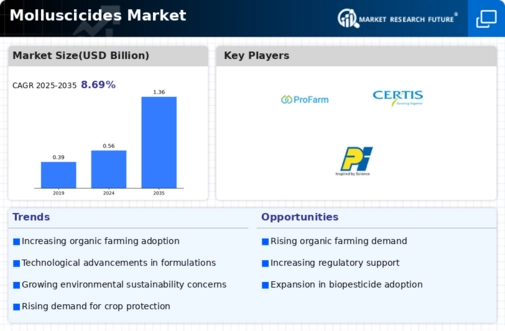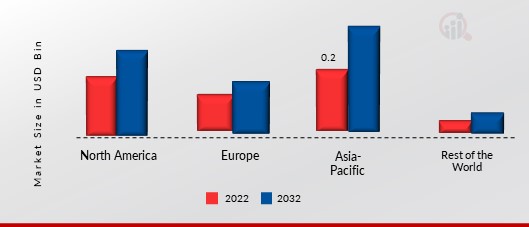-
Executive Summary
-
Scope of the Report
-
2.1
-
Market Definition
-
Scope of the Study
- Research Objectives
- Assumptions & Limitations
-
Market Structure
-
Market Research
-
Methodology
-
Research Process
-
Secondary Research
-
Primary
-
Research
-
Forecast Model
-
Market Landscape
-
Supply Chain Analysis
- Form Suppliers
- Manufacturers/Producers
- Distributors/Retailers/Wholesalers/E-Commerce
- End Users
-
Porter’s Five Forces Analysis
- Threat
- Bargaining Power of Buyers
- Bargaining Power
- Threat of Substitutes
- Internal Rivalry
-
of New Entrants
-
of Suppliers
-
5
-
Market Dynamics of the Global Molluscicides Market
-
Introduction
-
5.2
-
Drivers
-
Restraints
-
Opportunities
-
Challenges
-
Global
-
Molluscicides Market, by Type
-
Introduction
-
Chemical
-
6.2.1
-
Metaldehyde
-
6.2.1.2
-
Market Estimates & Forecast, 2024–2032
-
Market Estimates & Forecast, by Region, 2024–2032
-
& Forecast, by Region, 2024–2032
-
6.2.3.1
-
Market Estimates & Forecast, 2024–2032
-
Forecast, by Region, 2024–2032
-
& Forecast, 2024–2032
-
Region, 2024–2032
-
Methiocarb
-
Market Estimates & Forecast, 2024–2032
-
Market Estimates
-
Ferric Phosphate
-
Market Estimates &
-
Others
-
Market Estimates
-
Market Estimates & Forecast, by
-
Biological
- Market Estimates & Forecast,
- Market Estimates & Forecast, by Region, 2024–2032
-
Global Molluscicides Market, by Form
-
Introduction
-
Dry
- Market Estimates & Forecast, 2024–2032
- Market Estimates
-
& Forecast, by Region, 2024–2032
-
Liquid
- Market Estimates
- Market Estimates & Forecast, by Region,
-
& Forecast, 2024–2032
-
Global Molluscicides Market, by Crop type
-
Introduction
-
Vegetables & Fruits
- Market Estimates & Forecast, 2024–2032
- Market Estimates & Forecast, by Region, 2024–2032
-
Cereals
- Market Estimates & Forecast, 2024–2032
-
& Grains
-
8.3.2
-
Market Estimates & Forecast, by Region, 2024–2032
-
Oilseeds &
- Market Estimates & Forecast, 2024–2032
- Market
-
Pulses
-
Estimates & Forecast, by Region, 2024–2032
-
Ornaments and Turf
- Market Estimates & Forecast, 2024–2032
- Market Estimates
-
& Forecast, by Region, 2024–2032
-
Others
- Market Estimates
- Market Estimates & Forecast, by Region,
-
& Forecast, 2024–2032
-
Global Molluscicides Market, by Region
-
Introduction
-
North America
- Market Estimates & Forecast, 2024–2032
- Market Estimates & Forecast, by Type, 2024–2032
- Market
- Market Estimates &
- US
-
Estimates & Forecast, by Form, 2024–2032
-
Forecast, by Crop type, 2024–2032
-
& Forecast, 2024–2032
-
Type, 2024–2032
-
9.2.6
-
Canada
-
9.2.6.2
-
Market Estimates & Forecast, by Type, 2024–2032
-
& Forecast, by Form, 2024–2032
-
by Crop type, 2024–2032
-
Forecast, 2024–2032
-
9.3
-
Europe
-
Estimates & Forecast, by Type, 2024–2032
-
Forecast, by Form, 2024–2032
-
Crop type, 2024–2032
-
Forecast, 2024–2032
-
9.3.6
-
France
-
9.3.6.2
-
Market Estimates
-
Market Estimates & Forecast,
-
Mexico
-
Market Estimates &
-
Market Estimates & Forecast, by Type,
-
Market Estimates & Forecast, by Form, 2024–2032
-
Market Estimates & Forecast, by Crop type, 2024–2032
-
Market Estimates & Forecast, 2024–2032
-
Market
-
Market Estimates &
-
Market Estimates & Forecast, by
-
Germany
-
Market Estimates &
-
Market Estimates & Forecast, by Type,
-
Market Estimates & Forecast, by Form, 2024–2032
-
Market Estimates & Forecast, by Crop type, 2024–2032
-
Market Estimates & Forecast, 2024–2032
-
Market Estimates & Forecast, by Type, 2024–2032
-
& Forecast, by Form, 2024–2032
-
by Crop type, 2024–2032
-
Forecast, 2024–2032
-
9.3.8
-
Spain
-
9.3.8.2
-
Market Estimates
-
Market Estimates & Forecast,
-
Italy
-
Market Estimates &
-
Market Estimates & Forecast, by Type,
-
Market Estimates & Forecast, by Form, 2024–2032
-
Market Estimates & Forecast, by Crop type, 2024–2032
-
Market Estimates & Forecast, 2024–2032
-
Market Estimates & Forecast, by Type, 2024–2032
-
& Forecast, by Form, 2024–2032
-
by Crop type, 2024–2032
-
Forecast, 2024–2032
-
9.3.10
-
Rest of Europe
-
9.3.10.3
-
Market Estimates
-
Market Estimates & Forecast,
-
UK
-
Market Estimates &
-
Market Estimates & Forecast, by Type,
-
Market Estimates & Forecast, by Form, 2024–2032
-
Market Estimates & Forecast, by Crop type, 2024–2032
-
Market Estimates & Forecast, 2024–2032
-
Market Estimates & Forecast, by Type, 2024–2032
-
Market Estimates & Forecast, by Form, 2024–2032
-
& Forecast, by Crop type, 2024–2032
-
Estimates & Forecast, 2024–2032
-
by Type, 2024–2032
-
9.4.5
-
China
-
9.4.5.2
-
Market Estimates
-
Asia-Pacific
- Market
- Market Estimates & Forecast,
- Market Estimates & Forecast, by Form, 2024–2032
- Market Estimates & Forecast, by Crop type, 2024–2032
-
Market Estimates & Forecast, by Type, 2024–2032
-
& Forecast, by Form, 2024–2032
-
by Crop type, 2024–2032
-
Forecast, 2024–2032
-
9.4.7
-
Japan
-
9.4.7.2
-
Market Estimates
-
Market Estimates & Forecast,
-
India
-
Market Estimates &
-
Market Estimates & Forecast, by Type,
-
Market Estimates & Forecast, by Form, 2024–2032
-
Market Estimates & Forecast, by Crop type, 2024–2032
-
Market Estimates & Forecast, 2024–2032
-
Market Estimates & Forecast, by Type, 2024–2032
-
& Forecast, by Form, 2024–2032
-
by Crop type, 2024–2032
-
9.4.8.1
-
Market Estimates & Forecast, 2024–2032
-
Forecast, by Type, 2024–2032
-
by Form, 2024–2032
-
Forecast, 2024–2032
-
9.5
-
Rest of the World (RoW)
-
Estimates & Forecast, by Form, 2024–2032
-
Forecast, by Crop type, 2024–2032
-
Estimates & Forecast, 2024–2032
-
by Type, 2024–2032
-
9.5.6.3
-
Market Estimates
-
Market Estimates & Forecast,
-
Australia & New Zealand
-
Market Estimates &
-
Market Estimates & Forecast,
-
Market Estimates & Forecast, by Crop type,
-
Rest of Asia-Pacific
-
Market Estimates &
-
Market Estimates & Forecast, by Type,
-
Market Estimates & Forecast, by Form, 2024–2032
-
Market Estimates & Forecast, by Crop type, 2024–2032
-
Market Estimates & Forecast, 2024–2032
-
Market Estimates & Forecast, by Type, 2024–2032
-
Market
-
Market Estimates &
-
South America
-
Market
-
Market Estimates & Forecast,
-
Market Estimates & Forecast, by Form,
-
Market Estimates & Forecast, by Crop type, 2024–2032
-
The Middle East
-
Market Estimates & Forecast, 2024–2032
-
Market Estimates & Forecast, by Type, 2024–2032
-
Market Estimates & Forecast, by Form, 2024–2032
-
& Forecast, by Crop type, 2024–2032
-
Estimates & Forecast, 2024–2032
-
by Type, 2024–2032
-
Market Estimates
-
Africa
-
Market
-
Market Estimates & Forecast,
-
Market Estimates & Forecast, by Form,
-
Market Estimates & Forecast, by Crop type, 2024–2032
-
Company Landscape
-
Introduction
-
Market Strategy
-
9.3
-
Key Development Analysis
-
(Expansions/ Mergers and Acquisitions/ Joint Ventures/
-
New Product Developments/ Agreements/ Investments
-
Company Profiles
-
11.1
-
Lonza Group AG
-
11.1.3
-
Product/Business Segment Overview
-
11.2.4
-
Strategy
-
Segment Overview
-
Analysis
-
11.4.4
-
Strategy
-
Bio Innovations
-
11.5.3
-
Product/Business Segment Overview
-
Overview
-
11.7
-
De Sangosse Ltd
-
11.7.3
-
Product/Business Segment Overview
-
11.8.4
-
Strategy
-
Ltd
-
Segment Overview
-
Analysis
-
Updates
-
Segment Overview
-
11.11.6
-
SWOT Analysis
-
11.12.2
-
Financial Updates
-
Corporation
-
11.13.3
-
Product/Business Segment Overview
-
Overview
-
11.15
-
Westland Horticulture Ltd.
-
Updates
-
Company Overview
-
Financial Updates
-
Strategy
-
Key Developments
-
SWOT Analysis
-
Bayer Cropscience AG
- Company Overview
- Financial Updates
- Product/Business Segment Overview
- Key Developments
- SWOT Analysis
-
BASF SE
- Company Overview
- Financial Updates
- Product/Business
- Strategy
- Key Developments
- SWOT
-
ADAMA Agricultural Solutions
- Company Overview
- Financial Updates
- Product/Business Segment Overview
- Key Developments
- SWOT Analysis
-
Marrone
- Company Overview
- Financial Updates
- Strategy
- Key Developments
- SWOT Analysis
-
American Vanguard Corporation
- Company
- Financial Updates
- Product/Business Segment Overview
- Strategy
- Key Developments
- SWOT Analysis
- Company Overview
- Financial Updates
- Strategy
- Key Developments
- SWOT Analysis
-
W. Neudorff GmbH KG
- Company Overview
- Financial Updates
- Product/Business Segment Overview
- Key Developments
- SWOT Analysis
-
Doff Portland
- Company Overview
- Financial Updates
- Product/Business
- Strategy
- Key Developments
- SWOT
-
Certis Europe
- Company Overview
- Financial
- Product/Business Segment Overview
- Strategy
- Key Developments
- SWOT Analysis
-
Syngenta AG
- Company Overview
- Financial Updates
- Product/Business
- Strategy
- Key Developments
-
PI Industries Ltd.
- Company Overview
- Product/Business Segment Overview
- Strategy
- Key Developments
- SWOT Analysis
-
Amvac Chemical
- Company Overview
- Financial Updates
- Strategy
- Key Developments
- SWOT Analysis
-
Chiltern Farm Chemicals Ltd.
- Company
- Financial Updates
- Product/Business Segment Overview
- Strategy
- Key Developments
- SWOT Analysis
- Company Overview
- Financial
- Product/Business Segment Overview
- Strategy
- Key Developments
- SWOT Analysis
-
Conclusion
-
LIST
-
OF TABLES
-
Global Molluscicides Market, by Region, 2024–2032 (USD
-
Million)
-
Global Molluscicides Market, by Type, 2024–2032 (USD
-
Million)
-
Global Molluscicides Market, by Form, 2024–2032 (USD
-
Million)
-
Global Molluscicides Market, by Crop Type, 2024–2032
-
(USD Million)
-
North America: Molluscicides Market, by Country, 2024–2032
-
(USD Million)
-
North America: Molluscicides Market, by Type, 2024–2032
-
(USD Million)
-
North America: Molluscicides Market, by Form, 2024–2032
-
(USD Million)
-
North America: Molluscicides Market, by Crop Type, 2024–2032
-
(USD Million)
-
US: Molluscicides Market, by Type, 2024–2032 (USD
-
Million)
-
US: Molluscicides Market, by Form, 2024–2032 (USD Million)
-
US: Molluscicides Market, by Crop Type, 2024–2032 (USD Million)
-
Canada: Molluscicides Market, by Type, 2024–2032 (USD Million)
-
Canada: Molluscicides Market, by Form, 2024–2032 (USD Million)
-
Canada: Molluscicides Market, by Crop Type, 2024–2032 (USD Million)
-
Mexico: Molluscicides Market, by Type, 2024–2032 (USD Million)
-
Mexico: Molluscicides Market, by Form, 2024–2032 (USD Million)
-
Mexico: Molluscicides Market, by Crop Type, 2024–2032 (USD Million)
-
Europe: Molluscicides Market, by Country, 2024–2032 (USD Million)
-
Europe: Molluscicides Market, by Type, 2024–2032 (USD Million)
-
Europe: Molluscicides Market, by Form, 2024–2032 (USD Million)
-
Europe: Molluscicides Market, by Crop Type, 2024–2032 (USD Million)
-
Germany: Molluscicides Market, by Type, 2024–2032 (USD Million)
-
Germany: Molluscicides Market, by Form, 2024–2032 (USD Million)
-
Germany: Molluscicides Market, by Crop Type, 2024–2032 (USD Million)
-
France: Molluscicides Market, by Type, 2024–2032 (USD Million)
-
France: Molluscicides Market, by Form, 2024–2032 (USD Million)
-
France: Molluscicides Market, by Crop Type, 2024–2032 (USD Million)
-
Italy: Molluscicides Market, by Type, 2024–2032 (USD Million)
-
Italy: Molluscicides Market, by Form, 2024–2032 (USD Million)
-
Italy: Molluscicides Market, by Crop Type, 2024–2032 (USD Million)
-
Spain: Molluscicides Market, by Type, 2024–2032 (USD Million)
-
Spain: Molluscicides Market, by Form, 2024–2032 (USD Million)
-
Spain: Molluscicides Market, by Crop Type, 2024–2032 (USD Million)
-
UK: Molluscicides Market, by Type, 2024–2032 (USD Million)
-
TABLE
-
UK: Molluscicides Market, by Form, 2024–2032 (USD Million)
-
TABLE 36
-
UK: Molluscicides Market, by Crop Type, 2024–2032 (USD Million)
-
TABLE
-
Rest of Europe: Molluscicides Market, by Type, 2024–2032 (USD Million)
-
Rest of Europe: Molluscicides Market, by Form, 2024–2032 (USD Million)
-
Rest of Europe: Molluscicides Market, by Crop Type, 2024–2032 (USD
-
Million)
-
Asia-Pacific: Molluscicides Market, by Country, 2024–2032
-
(USD Million)
-
Asia-Pacific: Molluscicides Market, by Type, 2024–2032
-
(USD Million)
-
Asia-Pacific: Molluscicides Market, by Form, 2024–2032
-
(USD Million)
-
Asia-Pacific: Molluscicides Market, by Crop Type, 2024–2032
-
(USD Million)
-
China: Molluscicides Market, by Type, 2024–2032
-
(USD Million)
-
China: Molluscicides Market, by Form, 2024–2032
-
(USD Million)
-
China: Molluscicides Market, by Crop Type, 2024–2032
-
(USD Million)
-
India: Molluscicides Market, by Type, 2024–2032
-
(USD Million)
-
India: Molluscicides Market, by Form, 2024–2032
-
(USD Million)
-
India: Molluscicides Market, by Crop Type, 2024–2032
-
(USD Million)
-
Japan: Molluscicides Market, by Type, 2024–2032
-
(USD Million)
-
Japan: Molluscicides Market, by Form, 2024–2032
-
(USD Million)
-
Japan: Molluscicides Market, by Crop Type, 2024–2032
-
(USD Million)
-
Rest of Asia-Pacific: Molluscicides Market, by Type,
-
Rest of Asia-Pacific: Molluscicides
-
Market, by Form, 2024–2032 (USD Million)
-
Rest of Asia-Pacific:
-
Molluscicides Market, by Crop Type, 2024–2032 (USD Million)
-
TABLE 56
-
Rest of the World (RoW): Molluscicides Market, by Country, 2024–2032 (USD
-
Million)
-
Rest of the World (RoW): Molluscicides Market, by Type, 2024–2032
-
(USD Million)
-
Rest of the World (RoW): Molluscicides Market, by Form,
-
Rest of the World (RoW): Molluscicides
-
Market, by Crop Type, 2024–2032 (USD Million)
-
South America:
-
Molluscicides Market, by Type, 2024–2032 (USD Million)
-
South
-
America: Molluscicides Market, by Form, 2024–2032 (USD Million)
-
TABLE
-
South America: Molluscicides Market, by Crop Type, 2024–2032 (USD Million)
-
Middle East: Molluscicides Market, by Type, 2024–2032 (USD Million)
-
Middle East: Molluscicides Market, by Form, 2024–2032 (USD Million)
-
Middle East: Molluscicides Market, by Crop Type, 2024–2032 (USD
-
Million)
-
Africa: Molluscicides Market, by Type, 2024–2032 (USD
-
Million)
-
Africa: Molluscicides Market, by Form, 2024–2032 (USD
-
Million)
-
Africa: Molluscicides Market, by Crop Type, 2024–2032
-
(USD Million)
-
LIST OF FIGURES
-
Global Molluscicides Market Segmentation
-
Forecast Research Methodology
-
Five Forces Analysis of Global
-
Molluscicides Market
-
Value Chain of Global Molluscicides Market
-
Share of Global Molluscicides Market in 2022, by Country (%)
-
FIGURE
-
Global Molluscicides Market, by Region, 2024–2032,
-
Global
-
Molluscicides Market Size, by Type, 2022
-
Share of Global Molluscicides
-
Market, by Type, 2024–2032 (%)
-
Global Molluscicides Market Size,
-
by Form, 2022
-
Share of Global Molluscicides Market, by Form, 2024–2032
-
(%)
-
Global Molluscicides Market Size, by Crop type, 2022
-
FIGURE
-
Share of Global Molluscicides Market, by Crop type, 2024–2032 (%)








Leave a Comment